Copperheads are some of the most common snakes in the southeastern United States. These venomous reptiles are responsible for the most bites of any snake in the regions they live. Unfortunately, bites are often the result of misidentification or complete accident as they have incredible camouflage.
Today, we are going to take a look at these snakes and specifically learn how to identify them. How to Identify a Copperhead: The 5-Step Guide!
Let’s get started.
What is a Copperhead?
A copperhead is one of the three groups of American pit-vipers that live in the United States. Along with the cottonmouth (water moccasin) and all rattlesnake species, the copperhead completes the “triumvirate” of commonly seen venomous snakes in North America.
The copperhead can be found in the southeastern United States as far west as Texas and north as Massachusetts. Although not officially one of our “identification steps,” understanding where copperheads can be found is a great starting point for knowing if you have stumbled upon one.
Although these snakes are venomous, they are the least venomous of the three, and fatal bites are incredibly rare. In fact, most fatal bites are untreated or the result of an allergic reaction. Still, bites should be treated as a medical emergency, and professional help should be sought.
Due to the advanced camouflage of these snakes, bites often happen when a human accidentally reaches into copperhead territory, spooking the snake. Most of the time, you won’t see a copperhead if they don’t want to be seen. Still, sightings do happen with how common they are. Here is our guide on how to identify them.
How to Identify a Copperhead: The 5-Step Guide
Step 1: Coloration and Pattern

Copperheads are copper-colored and have a brown hourglass pattern on their backs.
©Creeping Things/Shutterstock.com
If you happen to find a snake you suspect of being a copperhead, the first thing you should look for is the coloration and pattern. As their name suggests, copperheads are copper-colored all over their bodies. This base copper later can be a shiny copper color, a pale brown color, or a reddish or pinkish-brown color, depending on where the snake was found.
On top of that base copper or brown color, will be a banding pattern that travels from the snake’s head to the tail. The banding pattern will almost always be in the shape of an hourglass, with the thinnest portion of the hourglass shape lying on the spine and the “sand reservoirs” laying on the sides of the snake. The hourglass shape isn’t always perfect, but it is by far the most identifiable pattern that distinguishes the snake from other species.
If you are able to see the belly of the snake (don’t try and flip it over), they are usually white or cream with a black spotted (some would say checkerboard) pattern. Other snakes do share this feature (corn snakes, for example), so it shouldn’t be used by itself.
An important note: Some subspecies of copperhead don’t have an hourglass pattern but a thick banding pattern. This is most common in Texas near desert regions where the “broad-banded copperhead” lives. Still, the rest of the steps should be enough to complete the identification.
Step 2: Eyes
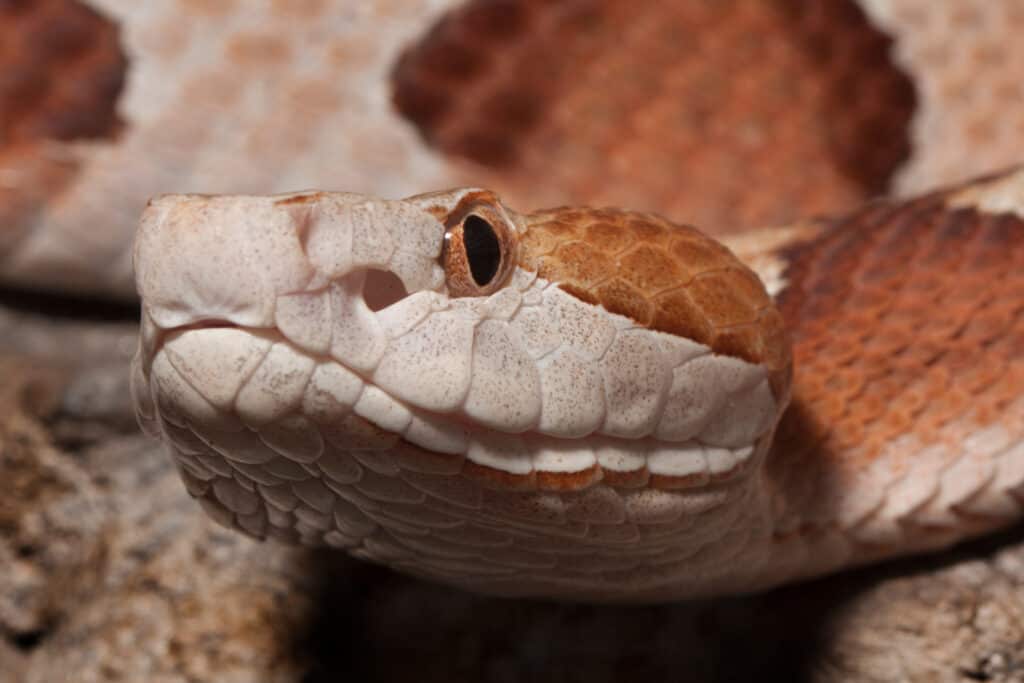
Copperheads have yellow, golden, or brown eyes, cat-like pupils, and an eyebrow scale.
©Mark_Kostich/Shutterstock.com
The eyes of the copperhead are another great identification clue since they are so distinct. All copperheads have a cat-slit pupil that is narrow at the top and bottom and thick in the middle. This cat-like eye is unique to venomous snakes in the United States, although the rule doesn’t work in reverse (not all venomous snakes have cat-eyes).
In addition to the shape of the eye, copperheads have either golden, yellow, or brown eyes. Golden or yellow eyes are the most common, but a light brown or sandy tan-colored eye is also possible.
Above the eyes is a ridged scale that gives the impression of an eyebrow. This ridged scale (known as keeling) gives a “mean” look to the snake and is highly unique.
Step 3: Heat-sensing pits
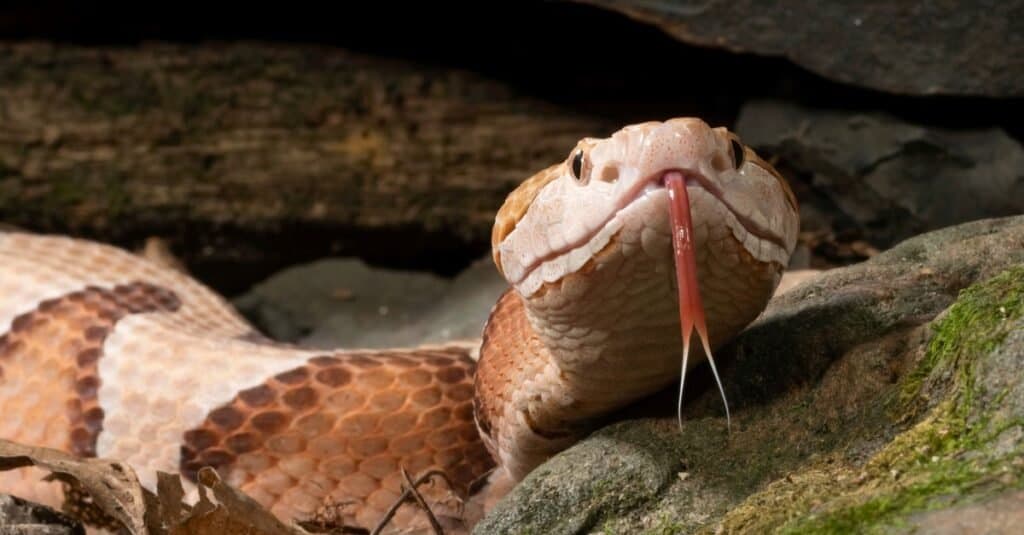
Heat-sensing pits are visible between the eyes and the snout on a copperhead.
©Joe McDonald/Shutterstock.com
As a member of the pit-viper family, copperheads have two heat-sensing pits along their snout. These pits allow them to track prey in all sorts of conditions. The heat-sensing pits are located between the eyes and nostrils of the snake. They are larger than the nostrils and appear to be deeper into the head of the snake than the nostrils.
The cottonmouth and rattlesnake share these heat-sensing pits with the copperhead.
Step 4: Head Shape
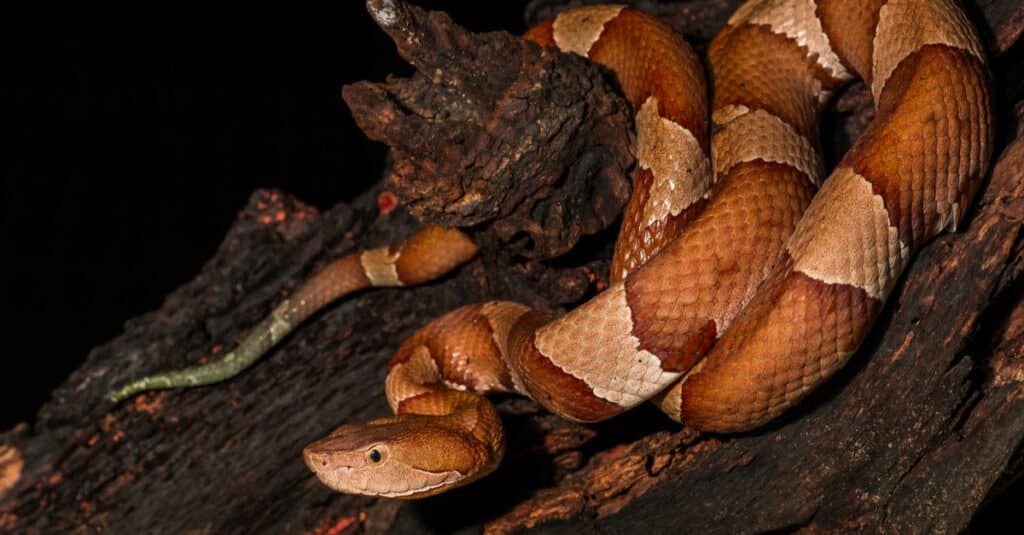
Copperheads have triangular heads with a pointed snout.
©Wildvet/Shutterstock.com
Another key factor for identifying a copperhead is the shape of the head. They are quite angular and shaped like a rounded triangle. The base of the triangle is connected to the neck, and the pointed end is where the snout is.
Step 5: Juvenile Identification

Juvenile copperheads have a yellow or green tail to attract small prey.
©Breck P. Kent/Shutterstock.com
Baby copperheads are very similar to adult copperheads, although there are a few variations. First, juveniles have a neon-yellow or green tip to their tails that is thought to be used to attract insects. Additionally, the bellies of juveniles aren’t checkerboarded, but they are still lighter cream-colored.
How Rare is a Copperhead Snake?
The North American copperhead is a frequently encountered venomous snake species in the eastern and central regions of the United States. It isn’t that rare.
Fortunately, its venom is not among the most potent, and bites are seldom fatal. Although the majority of copperhead bites are not considered life-threatening, they can inflict significant pain and necessitate prompt medical intervention.
Furthermore, certain copperhead bites may necessitate the administration of antivenom, while others, such as dry bites or non-venomous bites, may only necessitate evaluation and monitoring by a physician.
Similar species of snake
While understanding what a copperhead looks like is helpful, it can also be valuable to understand what a copperhead isn’t. Here are a few snakes that could be mistaken for a copperhead and also live in the same region.
Brown or banded watersnake
There are two species of watersnake that can look extremely similar to the copperhead, the brown and the banded watersnake. Neither are venomous or dangerous to humans.
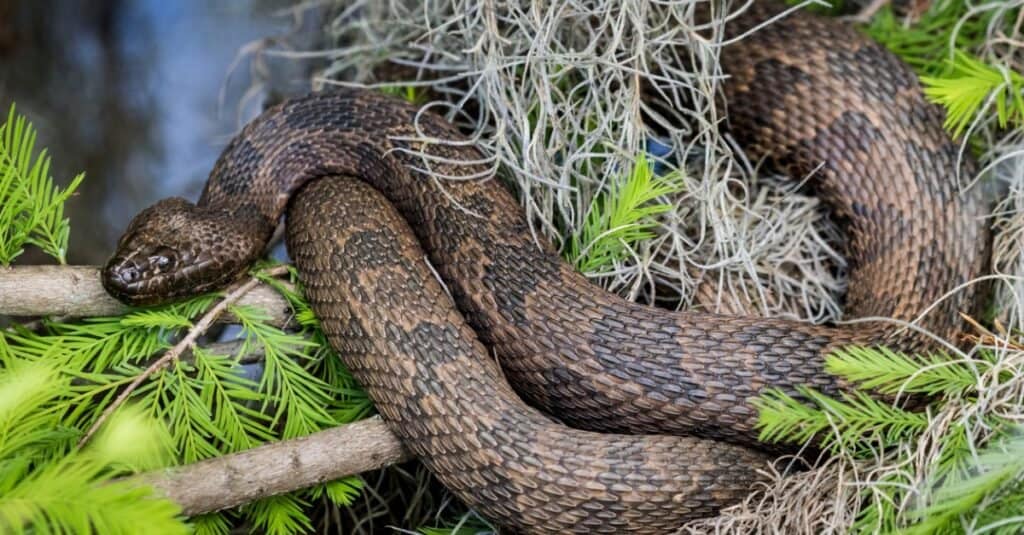
Brown watersnakes have square patterns and darker colors.
©iStock.com/csraphotography
The brown watersnake is a heavy-bodied snake with a rounded head, brown body, and small black markings on its back. The key differentiators between the two are that the brown watersnake has a round head, has black eyes, doesn’t have bands that encircle its body and the patterning is more square-shaped. Additionally, watersnakes don’t have heat-sensing pits or cat-slit eyes.
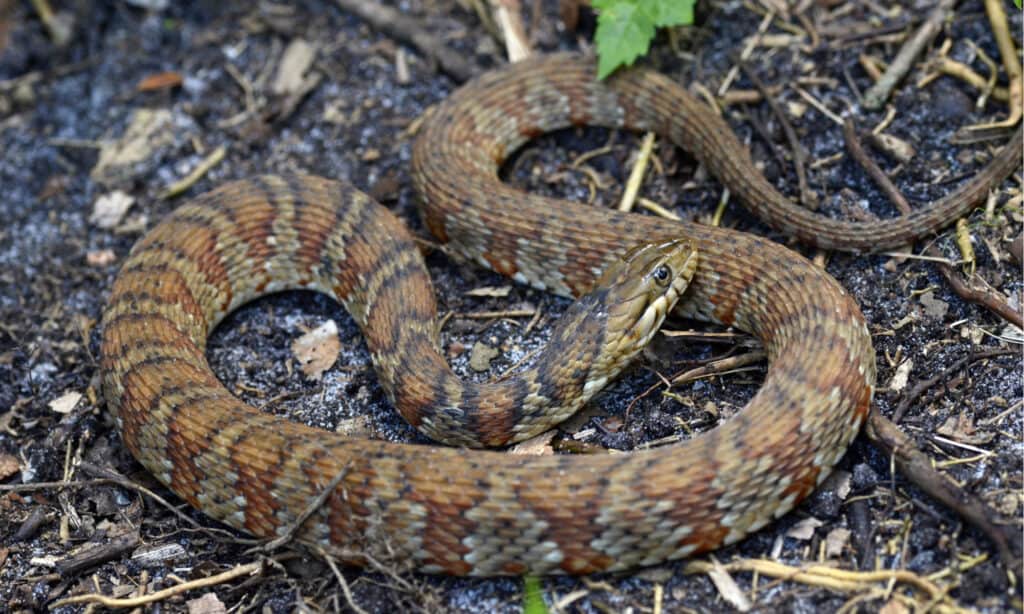
The banded watersnake has more bands than a copperhead that aren’t in the shape of an hourglass.
©Patrick K. Campbell/Shutterstock.com
The banded watersnake looks even more similar to the copperhead in some instances. They are brown or reddish-brown snakes that have darker bands from head to tail, just like the copperhead. The difference between the two patterns is that the band watersnake pattern is thin on the sides and thicker in the middle near the spine, whereas the copperhead has an hourglass-shaped pattern. Additionally, watersnakes don’t have cat-slit eyes or heat-sensing pits. The banded watersnake also has black lines along its jaw.
Cottonmouth
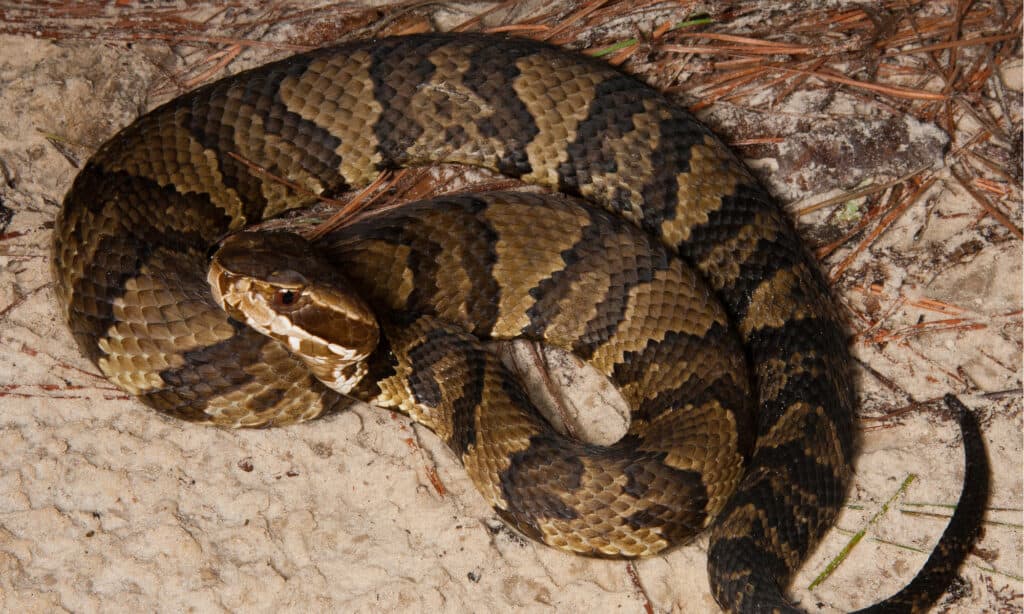
Cottonmouths are generally larger, have normal bands instead of hourglasses, and have white mouths.
©Nathan A Shepard/Shutterstock.com
The cottonmouth is related to the copperhead and is one of the more venomous snakes in the United States. They get their name from their defensive habit of flashing their white mouths, signaling a potential threat to back down. Cottonmouths have triangular heads, elliptical pupils, and a somewhat similar body shape to the copperhead, although they are usually thicker and larger overall.
The best way to distinguish the two is through coloration and banding patterns. Cottonmouths have white mouths, are darker colored, and don’t have an hourglass banding pattern (although they do have bands).
The photo featured at the top of this post is © Creeping Things/Shutterstock.com
Discover the "Monster" Snake 5X Bigger than an Anaconda
Every day A-Z Animals sends out some of the most incredible facts in the world from our free newsletter. Want to discover the 10 most beautiful snakes in the world, a "snake island" where you're never more than 3 feet from danger, or a "monster" snake 5X larger than an anaconda? Then sign up right now and you'll start receiving our daily newsletter absolutely free.
Thank you for reading! Have some feedback for us? Contact the AZ Animals editorial team.






